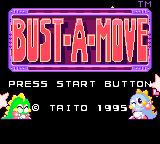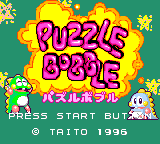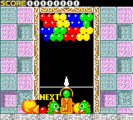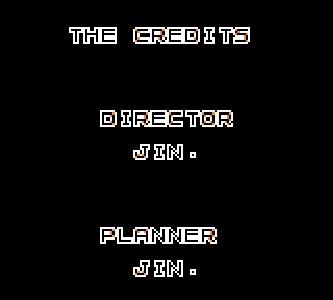Difference between revisions of "Bust-A-Move"
From Sega Retro
m (spelling/grammar, typos fixed: secton → section) |
|||
| (62 intermediate revisions by 19 users not shown) | |||
| Line 1: | Line 1: | ||
{{Bob | {{Bob | ||
| bobscreen=Bustamove Title.png | | bobscreen=Bustamove Title.png | ||
| − | | | + | | bobscreen2=Bustamove JP Title.png |
| − | | | + | | tab1=US |
| − | | publisher=[[Taito]] | + | | tab2=JP |
| − | | | + | | licensor={{company|[[Taito]]|region=US}} |
| + | | publisher={{company|[[Taito]]{{ref|http://gdri.smspower.org/wiki/index.php/Santos_(2)}}|region=JP}}{{company|[[Sega]]{{ref|http://gdri.smspower.org/wiki/index.php/Santos_(2)}}|region=US}} | ||
| + | | developer=[[Santos (later)|Santos]]{{ref|http://gdri.smspower.org/wiki/index.php/Santos_(2)}} | ||
| system=[[Sega Game Gear]] | | system=[[Sega Game Gear]] | ||
| − | + | | sounddriver= | |
| − | | sounddriver= | + | | peripherals=[[Gear-to-Gear Cable]] |
| − | | peripherals= | ||
| players=1-2 | | players=1-2 | ||
| − | | genre=Puzzle | + | | originalsystem=Taito B System |
| − | | | + | | genre=Puzzle{{fileref|Bustamove GG JP Box Front.jpg}}{{ref|https://web.archive.org/web/20130101202427/http://sega.jp/fb/segahard/gg/soft_licensee.html}} |
| − | | | + | | releases={{releasesGG |
| − | | | + | | gg_date_jp=1996-08-02{{ref|https://web.archive.org/web/20130101202427/http://sega.jp/fb/segahard/gg/soft_licensee.html}} |
| − | | | + | | gg_rrp_jp=4,800 |
| − | | | + | | gg_code_jp=T-11047 |
| − | | | + | | gg_date_us=1996 |
| − | | | + | | gg_code_us=2567 |
| − | | | + | | gg_rating_us=ka |
| − | | | + | }} |
| − | | | + | | otherformats={{NonSega|Arcade|NGCD|3DO|SNES|WS|PC}} |
| − | | | + | | savetype={{SaveType |
| − | | | + | |GG|password |
| − | | | + | }} |
| − | | | + | }} |
| − | | | + | '''''{{PAGENAME}}''''', known as '''''Puzzle Bobble''''' (パズルボブル) in Japan, is a puzzle game created by [[Taito]] as a spin-off to their popular ''[[Bubble Bobble]]'' series. Originally released in arcades, the game was brought to the [[Sega Game Gear]] in 1996 by [[Santos]]. |
| − | | | + | |
| − | | | + | It was the last third-party Game Gear game released in Japan and the only non-Sega game to use the [[Kid's Gear]] brand. |
| − | | | + | |
| − | | | + | ==Gameplay== |
| − | | | + | {{ScreenThumb|Bust-A-Move GG, Stage 1.png|align=left|width=160|Gameplay}} |
| − | | | + | The objective of the game is to clear all the bubbles from the arena without any bubble crossing the bottom line. To do so, Bub and Bob fire bubbles from the Bubble Launcher at the bottom. The Bubble Launcher is aimed with {{left}} or {{right}} and fired with {{2}}. The launcher can be aimed more precisely by holding {{1}} while pressing {{left}} or {{right}}. The fired bubbles travel in straight lines (possibly bouncing off the sidewalls of the arena), stopping when they touch other bubbles or reach the top of the arena. If a bubble touches identically-colored bubbles, forming a group of three or more, those bubbles (as well as any bubbles hanging from them) are removed from the field of play and points are awarded. The color of bubbles fired is randomly generated and chosen from the colors of bubbles still left on the screen. Bubbles are fired automatically if the player is idle. |
| − | | | + | |
| − | | | + | After every few shots, the ceiling of the playing arena drops downwards slightly, along with all the bubbles stuck to it. The screen shakes the turn before the ceiling drops as a warning to the player. The number of shots between each drop of the ceiling is influenced by the number of bubble colors remaining. The closer the bubbles get to the bottom of the screen, the faster the music plays, and if they cross the line at the bottom, the game is over. Because of this constraint, each round effectively must be completed within a certain number of moves. Most rounds are designed such that the player must be strategic and pop bubbles with longer chains of bubbles hanging from them in order to finish before the ceiling drops too low. |
| + | |||
| + | The game includes the 30 rounds from the original arcade game along with 70 new ones for a total of 100 rounds (including the final boss fight with Super Drunk). These are the same 100 rounds that are also available in the [[Super NES]] and [[3DO]] versions of the game. The game has a password system so the player can continue from any level later. | ||
| + | |||
| + | There is also a Versus Mode and a Challenge Mode. The Versus Mode can be played against the computer or against another person over a Gear-to-Gear Cable. In this mode, any bubbles hanging off the busted bubbles are dropped on the opponent's side. Against the computer, the player tries to win the best of three rounds against ten different computer opponents. Against a person, players can choose to play a single round or a best of three, five, or seven games. The Challenge Mode is an endless mode that continually feeds new lines of bubbles as the player eliminates them. | ||
| + | |||
| + | ===Special bubbles=== | ||
| + | There are three new bubble types absent from the arcade game, which have special effects when they are hit by another bubble. | ||
| + | {{InfoTable|imagewidths=50| | ||
| + | {{InfoRow | ||
| + | | title=Lightning Bubble | ||
| + | | bgcolor=#000 | ||
| + | | sprite={{ScaleX | {{sprite | Bust-A-Move GG, Bubbles.png | 3 | crop_width=8 | crop_height=9 | crop_x=56 | crop_y=0}} | currentwidth=8 | wantedwidth=9}} | ||
| + | | desc=Shoots a bolt of lightning horizontally, breaking all bubbles in its path. | ||
| + | }} | ||
| + | {{InfoRow | ||
| + | | title=Flame Bubble | ||
| + | | bgcolor=#000 | ||
| + | | sprite={{ScaleX | {{sprite | Bust-A-Move GG, Bubbles.png | 3 | crop_width=8 | crop_height=9 | crop_x=72 | crop_y=0}} | currentwidth=8 | wantedwidth=9}} | ||
| + | | desc=Pops all bubbles in a radius around it. | ||
| + | }} | ||
| + | {{InfoRow | ||
| + | | title=Water Bubble | ||
| + | | bgcolor=#000 | ||
| + | | sprite={{ScaleX | {{sprite | Bust-A-Move GG, Bubbles.png | 3 | crop_width=8 | crop_height=9 | crop_x=64 | crop_y=0}} | currentwidth=8 | wantedwidth=9}} | ||
| + | | desc=Releases a waterfall that paints all bubbles it touches the same color. | ||
| + | }} | ||
| + | }} | ||
| + | |||
| + | ===Rounds=== | ||
| + | {{mainArticle|{{PAGENAME}}/Maps}} | ||
| + | |||
| + | ==History== | ||
| + | The format of ''Bust-A-Move'' has been extremely successful for Taito, moreso than the original ''Bubble Bobble'' or ''[[Rainbow Islands]]''. As such, the ''Bust-A-Move'' series has seen numerous sequels (starting with ''[[Bust-A-Move 2: Arcade Edition]]'') and several similar clones. | ||
| + | |||
| + | ==Versions== | ||
| + | ===Localised names=== | ||
| + | {{aka | ||
| + | |us_name=Bust-A-Move | ||
| + | |jp_name=パズルボブル | ||
| + | |jp_trans=Puzzle Bobble | ||
}} | }} | ||
| − | |||
| − | + | ==Production credits== | |
| + | {{multicol| | ||
| + | {{creditstable| | ||
| + | *'''Director:''' Jin. | ||
| + | *'''Planner:''' Jin. | ||
| + | *'''Programmers:''' Arinko, Goripon | ||
| + | *'''Graphics Designers:''' Some1 | ||
| + | *'''Sound by:''' Tama | ||
| + | *'''Manual Designer:''' Kazuo Nakagawa | ||
| + | *'''Special Thanks to:''' Shouji Takahashi, Yuji Koga, Midori Tokutomi, Yuichi Kanno, Satoru Tanabe | ||
| + | *'''Producers:''' Seizo Matsutaka, Takeo Shirasaka | ||
| + | *'''Executive Producer:''' Koichi Nakamura | ||
| + | | source=In-game credits | ||
| + | | pdf=Bust-A-Move GG credits.pdf | ||
| + | | console=GG | ||
| + | }} | ||
| + | }} | ||
| − | + | ==Magazine articles== | |
| + | {{mainArticle|{{PAGENAME}}/Magazine articles}} | ||
| − | ==Physical | + | ==Physical scans== |
| − | {{ | + | {{ratings|GG}} |
| + | {{Scanbox | ||
| + | | console=Game Gear | ||
| + | | region=JP | ||
| + | | front=Bustamove GG JP Box Front.jpg | ||
| + | | back=PuzzleBobble GG JP Box Back.jpg | ||
| + | | spinemissing=yes | ||
| + | | cart=PuzzleBobble GG JP Cart.jpg | ||
| + | | cartback=PuzzleBobble GG JP Cart Back.jpg | ||
| + | }} | ||
| + | {{Scanbox | ||
| console=Game Gear | | console=Game Gear | ||
| region=US | | region=US | ||
| front=Bustamove GG US Box Front.jpg | | front=Bustamove GG US Box Front.jpg | ||
| + | | back=Bustamove GG US Box Back.jpg | ||
| + | | spinemissing=yes | ||
| + | | cart=BustAMove GG US Cart.jpg | ||
| + | | manual=Bust-A-Move GG US Manual.pdf | ||
}} | }} | ||
| − | {{ | + | |
| − | | | + | ==Technical information== |
| − | | | + | ===ROM dump status=== |
| − | | | + | {{romtable| |
| + | {{rom|GG|sha1=E6BB5F72CFFB11C8DD44AC3E378088B04CEC1297|md5=50A41B6B8062095C142ACD186B6118C9|crc32=C90F29EF|size=256KB|date=|source=Cartridge (US/EU)|comments=|quality=good|prototype=}} | ||
| + | {{rom|GG|sha1=15568554CF6474E1AD64401217B702A048113A2D|md5=1713ECEBA681849BE8E36F5F62654405|crc32=8E54EE04|size=256KB|date=|source=Cartridge (JP)|comments=|quality=good|prototype=}} | ||
}} | }} | ||
| − | {{ | + | |
| + | ==External links== | ||
| + | * Sega of America webpage: [https://web.archive.org/web/19980223122925/http://www.sega.com:80/products/games/00521.html Game Gear] | ||
| + | |||
| + | ==References== | ||
| + | <references/> | ||
| + | |||
| + | {{BustAMoveOmni}} | ||
{{BubbleBobble}} | {{BubbleBobble}} | ||
| − | |||
| − | |||
| − | |||
| − | |||
Latest revision as of 08:47, 18 April 2024
| |||||||||||||||
| Bust-A-Move | |||||||||||||||
|---|---|---|---|---|---|---|---|---|---|---|---|---|---|---|---|
| System(s): Sega Game Gear | |||||||||||||||
| Publisher: Taito[1] (JP) Sega[1] (US) | |||||||||||||||
| Developer: Santos[1] | |||||||||||||||
| Licensor: Taito (US) | |||||||||||||||
| Original system(s): Taito B System | |||||||||||||||
| Peripherals supported: Gear-to-Gear Cable | |||||||||||||||
| Genre: Puzzle[2][3] | |||||||||||||||
| Number of players: 1-2 | |||||||||||||||
| |||||||||||||||
|
Bust-A-Move, known as Puzzle Bobble (パズルボブル) in Japan, is a puzzle game created by Taito as a spin-off to their popular Bubble Bobble series. Originally released in arcades, the game was brought to the Sega Game Gear in 1996 by Santos.
It was the last third-party Game Gear game released in Japan and the only non-Sega game to use the Kid's Gear brand.
Contents
Gameplay
The objective of the game is to clear all the bubbles from the arena without any bubble crossing the bottom line. To do so, Bub and Bob fire bubbles from the Bubble Launcher at the bottom. The Bubble Launcher is aimed with ![]() or
or ![]() and fired with
and fired with ![]() . The launcher can be aimed more precisely by holding
. The launcher can be aimed more precisely by holding ![]() while pressing
while pressing ![]() or
or ![]() . The fired bubbles travel in straight lines (possibly bouncing off the sidewalls of the arena), stopping when they touch other bubbles or reach the top of the arena. If a bubble touches identically-colored bubbles, forming a group of three or more, those bubbles (as well as any bubbles hanging from them) are removed from the field of play and points are awarded. The color of bubbles fired is randomly generated and chosen from the colors of bubbles still left on the screen. Bubbles are fired automatically if the player is idle.
. The fired bubbles travel in straight lines (possibly bouncing off the sidewalls of the arena), stopping when they touch other bubbles or reach the top of the arena. If a bubble touches identically-colored bubbles, forming a group of three or more, those bubbles (as well as any bubbles hanging from them) are removed from the field of play and points are awarded. The color of bubbles fired is randomly generated and chosen from the colors of bubbles still left on the screen. Bubbles are fired automatically if the player is idle.
After every few shots, the ceiling of the playing arena drops downwards slightly, along with all the bubbles stuck to it. The screen shakes the turn before the ceiling drops as a warning to the player. The number of shots between each drop of the ceiling is influenced by the number of bubble colors remaining. The closer the bubbles get to the bottom of the screen, the faster the music plays, and if they cross the line at the bottom, the game is over. Because of this constraint, each round effectively must be completed within a certain number of moves. Most rounds are designed such that the player must be strategic and pop bubbles with longer chains of bubbles hanging from them in order to finish before the ceiling drops too low.
The game includes the 30 rounds from the original arcade game along with 70 new ones for a total of 100 rounds (including the final boss fight with Super Drunk). These are the same 100 rounds that are also available in the Super NES and 3DO versions of the game. The game has a password system so the player can continue from any level later.
There is also a Versus Mode and a Challenge Mode. The Versus Mode can be played against the computer or against another person over a Gear-to-Gear Cable. In this mode, any bubbles hanging off the busted bubbles are dropped on the opponent's side. Against the computer, the player tries to win the best of three rounds against ten different computer opponents. Against a person, players can choose to play a single round or a best of three, five, or seven games. The Challenge Mode is an endless mode that continually feeds new lines of bubbles as the player eliminates them.
Special bubbles
There are three new bubble types absent from the arcade game, which have special effects when they are hit by another bubble.
| Lightning Bubble | |
|---|---|
| Shoots a bolt of lightning horizontally, breaking all bubbles in its path. | |
| Flame Bubble | |
| Pops all bubbles in a radius around it. | |
| Water Bubble | |
| Releases a waterfall that paints all bubbles it touches the same color. |
Rounds
- Main article: Bust-A-Move/Maps.
History
The format of Bust-A-Move has been extremely successful for Taito, moreso than the original Bubble Bobble or Rainbow Islands. As such, the Bust-A-Move series has seen numerous sequels (starting with Bust-A-Move 2: Arcade Edition) and several similar clones.
Versions
Localised names
| Language | Localised Name | English Translation |
|---|---|---|
| English (US) | Bust-A-Move | Bust-A-Move |
| Japanese | パズルボブル | Puzzle Bobble |
Production credits
- Director: Jin.
- Planner: Jin.
- Programmers: Arinko, Goripon
- Graphics Designers: Some1
- Sound by: Tama
- Manual Designer: Kazuo Nakagawa
- Special Thanks to: Shouji Takahashi, Yuji Koga, Midori Tokutomi, Yuichi Kanno, Satoru Tanabe
- Producers: Seizo Matsutaka, Takeo Shirasaka
- Executive Producer: Koichi Nakamura
Magazine articles
- Main article: Bust-A-Move/Magazine articles.
Physical scans
| Sega Retro Average | ||||||||||||||
|---|---|---|---|---|---|---|---|---|---|---|---|---|---|---|
|
| 69 | |
|---|---|
| Based on 2 reviews | |
Technical information
ROM dump status
| System | Hash | Size | Build Date | Source | Comments | |||||||||
|---|---|---|---|---|---|---|---|---|---|---|---|---|---|---|
| ✔ |
|
256kB | Cartridge (US/EU) | |||||||||||
| ✔ |
|
256kB | Cartridge (JP) |
External links
- Sega of America webpage: Game Gear
References
- ↑ 1.0 1.1 1.2 http://gdri.smspower.org/wiki/index.php/Santos_(2)
- ↑ File:Bustamove GG JP Box Front.jpg
- ↑ 3.0 3.1 http://sega.jp/fb/segahard/gg/soft_licensee.html (Wayback Machine: 2013-01-01 20:24)
- ↑ File:Bust-A-Move GG credits.pdf
- ↑ Famitsu, "1996-09-06" (JP; 1996-08-23), page 29
- ↑ VideoGames, "March 1996" (US; 1996-02-20), page 80
| Bust-A-Move | |
|---|---|
|
Main page | Comparisons | Maps | Hidden content | Magazine articles | Reception | |
| Bubble Bobble/Rainbow Islands games for Sega systems |
|---|
| Bubble Bobble (1988) | Rainbow Islands Extra (1990) | Rainbow Islands (1993) | Bubble Bobble also featuring Rainbow Islands (1996) | Bubble Symphony (1997) |
| Puzzle Bobble/Bust-a-Move games for Sega systems |
| Bust-A-Move (1996) | Bust-A-Move 2: Arcade Edition (1996) | Bust-A-Move 3 (1997) | Bust-A-Move 4 (2000) | Azumanga Daioh Puzzle Bobble (2002) |
| Unlicensed Bubble Bobble/Rainbow Islands games for Sega systems |
| Super Bubble Bobble MD (1995) |








